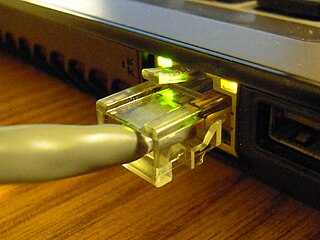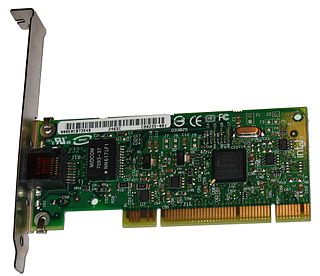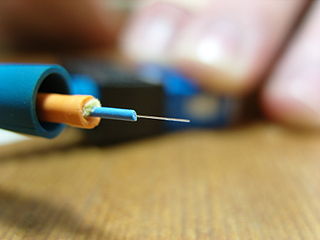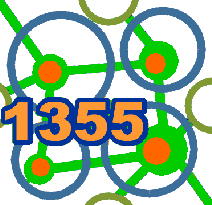Related Research Articles

Ethernet is a family of wired computer networking technologies commonly used in local area networks (LAN), metropolitan area networks (MAN) and wide area networks (WAN). It was commercially introduced in 1980 and first standardized in 1983 as IEEE 802.3. Ethernet has since been refined to support higher bit rates, a greater number of nodes, and longer link distances, but retains much backward compatibility. Over time, Ethernet has largely replaced competing wired LAN technologies such as Token Ring, FDDI and ARCNET.

Fiber Distributed Data Interface (FDDI) is a standard for data transmission in a local area network. It uses optical fiber as its standard underlying physical medium.

In computer networking, Fast Ethernet physical layers carry traffic at the nominal rate of 100 Mbit/s. The prior Ethernet speed was 10 Mbit/s. Of the Fast Ethernet physical layers, 100BASE-TX is by far the most common.

In computer networking, Gigabit Ethernet is the term applied to transmitting Ethernet frames at a rate of a gigabit per second. The most popular variant, 1000BASE-T, is defined by the IEEE 802.3ab standard. It came into use in 1999, and has replaced Fast Ethernet in wired local networks due to its considerable speed improvement over Fast Ethernet, as well as its use of cables and equipment that are widely available, economical, and similar to previous standards. The first standard for faster 10 Gigabit Ethernet was approved in 2002.

Telecommunications in Armenia involves the availability and use of electronic devices and services, such as the telephone, television, radio or computer, for the purpose of communication. The various telecommunications systems found and used in Armenia includes radio, television, fixed and mobile telephones, and the internet.
10BROAD36 is an obsolete computer network standard in the Ethernet family. It was developed during the 1980s and specified in IEEE 802.3b-1985. The Institute of Electrical and Electronics Engineers standards committee IEEE 802 published the standard that was ratified in 1985 as an additional section 11 to the base Ethernet standard. It was also issued as ISO/IEC 8802-3 in 1989.
XENPAK is a multisource agreement (MSA), instigated by Agilent Technologies and Agere Systems, that defines a fiber-optic or wired transceiver module which conforms to the 10 Gigabit Ethernet (10GbE) standard of the Institute of Electrical and Electronics Engineers (IEEE) 802.3 working group. The MSA group received input from both transceiver and equipment manufacturers during the definition process. XENPAK has been replaced by more compact devices providing the same functionality.
Hybrid fiber-coaxial (HFC) is a broadband telecommunications network that combines optical fiber and coaxial cable. It has been commonly employed globally by cable television operators since the early 1990s.
LattisNet was a family of computer networking hardware and software products built and sold by SynOptics Communications during the 1980s. Examples were the 1000, 2500 and 3000 series of LattisHub network hubs. LattisNet was the first implementation of 10 Megabits per second local area networking over unshielded twisted pair wiring in a star topology.

Multi-mode optical fiber is a type of optical fiber mostly used for communication over short distances, such as within a building or on a campus. Multi-mode links can be used for data rates up to 800 Gbit/s. Multi-mode fiber has a fairly large core diameter that enables multiple light modes to be propagated and limits the maximum length of a transmission link because of modal dispersion. The standard G.651.1 defines the most widely used forms of multi-mode optical fiber.

Plastic optical fiber (POF) or polymer optical fiber is an optical fiber that is made out of polymer. Similar to glass optical fiber, POF transmits light through the core of the fiber. Its chief advantage over the glass product, other aspect being equal, is its robustness under bending and stretching.

IEEE Standard 1355-1995, IEC 14575, or ISO 14575 is a data communications standard for Heterogeneous Interconnect (HIC).

Fiber to the x or fiber in the loop is a generic term for any broadband network architecture using optical fiber to provide all or part of the local loop used for last mile telecommunications. As fiber optic cables are able to carry much more data than copper cables, especially over long distances, copper telephone networks built in the 20th century are being replaced by fiber.
Ethernet in the first mile (EFM) refers to using one of the Ethernet family of computer network technologies between a telecommunications company and a customer's premises. From the customer's point of view, it is their first mile, although from the access network's point of view it is known as the last mile.

Fiber-optic communication is a method of transmitting information from one place to another by sending pulses of infrared or visible light through an optical fiber. The light is a form of carrier wave that is modulated to carry information. Fiber is preferred over electrical cabling when high bandwidth, long distance, or immunity to electromagnetic interference is required. This type of communication can transmit voice, video, and telemetry through local area networks or across long distances.
40 Gigabit Ethernet (40GbE) and 100 Gigabit Ethernet (100GbE) are groups of computer networking technologies for transmitting Ethernet frames at rates of 40 and 100 gigabits per second (Gbit/s), respectively. These technologies offer significantly higher speeds than 10 Gigabit Ethernet. The technology was first defined by the IEEE 802.3ba-2010 standard and later by the 802.3bg-2011, 802.3bj-2014, 802.3bm-2015, and 802.3cd-2018 standards. The first succeeding Terabit Ethernet specifications were approved in 2017.
The 10 Gbit/s Ethernet Passive Optical Network standard, better known as 10G-EPON allows computer network connections over telecommunication provider infrastructure. The standard supports two configurations: symmetric, operating at 10 Gbit/s data rate in both directions, and asymmetric, operating at 10 Gbit/s in the downstream direction and 1 Gbit/s in the upstream direction. It was ratified as IEEE 802.3av standard in 2009. EPON is a type of passive optical network, which is a point-to-multipoint network using passive fiber-optic splitters rather than powered devices for fan-out from hub to customers.
Terabit Ethernet (TbE) is Ethernet with speeds above 100 Gigabit Ethernet. The 400 Gigabit Ethernet and 200 Gigabit Ethernet standard developed by the IEEE P802.3bs Task Force using broadly similar technology to 100 Gigabit Ethernet was approved on December 6, 2017. On February 16, 2024 the 800 Gigabit Ethernet standard developed by the IEEE P802.3df Task Force was approved.

The Fiber Optic Association (FOA) is an international professional society of fiber optics. The FOA was founded in 1995 by a group of trainers from industry, government and education who wanted to create industry standards for training and certifying fiber optic technicians. The FOA is a not-for-profit 501(c)6 organization based in California, USA, that has over 200 affiliated training organizations in over 40 countries. FOA approves fiber optic training organizations and certifies their instructors who train designers, installers and operators of all types of fiber optic networks. FOA programs are used by many organizations, companies and trade unions to train and certify their workers.
Classic Ethernet is a family of 10 Mbit/s Ethernet standards, which is the first generation of Ethernet standards. In 10BASE-X, the 10 represents its maximum throughput of 10 Mbit/s, BASE indicates its use of baseband transmission, and X indicates the type of medium used. Classic Ethernet includes coax, twisted pair and optical variants. The first Ethernet standard was published in 1983 and classic Ethernet operating at 10 Mbit/s was the dominant form of Ethernet until the first standard for Fast Ethernet was approved in 1995.
References
- ↑ Cronin, William (15 January 1990). "Technical Approaches For Implementation Of CSMA/CD On A Fiber Optic Medium". Fiber Networking and Telecommunications. 1179– via Spie. Digital Library.